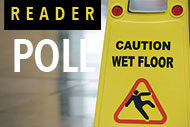
Image by Shutterstock
Architectural design of health care facilities, including technology and equipment, and its effect on patient safety has become a focus for health care risk managers.
To deliver safe and trusted health care, many key areas have to be considered, such as changes in the health care delivery processes, the culture of the organization and the physical environment.
The physical environment needs to be aligned with the current care delivery models to support the staff and the resources they depend on to ensure the safe delivery of care.
Impact of the environment
Understanding the interrelationships between humans, the tools they use and the environment in which they work is fundamental to the study of health care facility design and its effect on nursing performance as well as that of other care providers who interface with the facility. Humans are more apt to make errors in areas that are poorly designed.
When a serious patient-safety event occurs, the risk manager conducts a root-cause analysis in collaboration with a multidisciplinary team to identify the primary issue that caused the event. The analysis may identify a human factor that is related to the architectural design of the physical plant.
Latent errors are organizational or system factors that create conditions contributing to errors. They can lie dormant for months or even years before an event occurs. These errors only become evident when they combine with other factors that breach the system’s notification defenses. Examples include poorly designed facilities, which may have resulted in improperly located technology or equipment, as well as training gaps, staffing patterns and a poor safety culture.
Another example of how latent errors may affect patient safety is the impact of low lighting in a medication area. Low lighting could result in a medication error that otherwise would not occur where the lighting is ample for visibility. James Reason, an expert on human error and organizational processes, describes this as the “blunt end” rather than latent errors; where administrators, the work environment and resources determine the level of care delivered.
In the case of a patient-safety event caused by low lighting, the staff in the care area may not even realize that the lighting may have been a factor or root cause. The lighting decision could have been made when the area was designed years before, resulting in the latent error or blunt-end error. When a care area is changing from one type of care delivery to another (i.e., from a patient waiting area to a patient holding area), a failure-mode effects analysis (FMEA) should be completed by a team prior to the change.
Resources
An FMEA proactively looks at a process and possible failure points within the process, while a root-cause analysis is retrospectively conducted after the event has occurred. Root-cause analysis is subject to hindsight bias, which is like quarterbacking a Sunday football game on Monday.
Ensuring patient safety
Utilizing the six quality aims of the Institute of Medicine’s report, “Crossing the Quality Chasm: A New Health System for the 21st Century,” Kerm Henriksen and colleagues in the November 2007 issue of the Joint Commission Journal on Quality and Patient Safety identified the following six elements as critical to ensuring patent safety and quality of care. These aims and examples of their physical environment-related patient safety considerations include:
Patient-centeredness. Design improvements in patient rooms and visitors’ spaces as well as upgrading signage and improving access to information for patients. For example, when faced with an illness or emergency, an unfamiliar medical facility can cause stress or fear. Hospital signage is regulated for such considerations as emergency medical conditions, women in labor and Americans with disabilities, but thoughtful wayfinding signage is key in some situations and may provide increased safety to patients and staff. Wayfinding programs should set up a clear organizational system of information, so that visitors have consistent expectations for signage. Wayfinding information should be integrated within the hospital environment so that
signage is both functional and minimal; meets guidelines for accessibility and safety by providing information for all visitors regardless of physical abilities; and supports and communicates the facility brand through consistent messaging.
Safety. Design improvements in lighting, flooring and assistive devices can reduce falls; improvements in ventilation, surface decontamination and hand-washing stations can help to prevent infections; and design features can improve workflow and collaboration. For example, hand-washing stations must make sense within the care delivery environment. If a care provider must walk into a patient’s room or navigate past physical barriers to utilize a hand-washing station, the care provider may continue down the hall to where a hand-washing station is accessible or may even forgo hand washing entirely.
Effectiveness. Design interventions can improve visual lighting and noise control. For example, it has been shown that noise or interruptions occurring during critical medical tasks increase the rate of potential adverse medical events such as improper medication administration. Taking care to reduce noise in the care delivery area will have a positive effect on patient safety and potentially decrease inaccuracies in communication. Noise can be both a disruption and a barrier to communication, resulting in communication errors.
Efficiency: Increased standardization of room layouts and medical equipment locations can facilitate clinical work. Standardization is a key factor in highly reliable organizations and patient safety arenas. For example, when providers know where devices and supplies are located, they can consistently find those devices for urgent care and treatment. By minimizing distractions and delays caused by the inability to find equipment easily, the care provider’s attention remains focused on medical tasks, safety, timeliness and quality of care.
Timeliness. Designs should ensure a rapid response to patient needs, eliminate inefficiencies in the processes of care delivery and facilitate the clinical workspace. A helpful tool to identify inefficiencies in care delivery within a clinical workspace is a spaghetti diagram — a visual representation using a continuous flow line tracing the path of an item or activity through a process. The continuous flow line enables process teams and designers to identify redundancies in the workflow and opportunities to expedite process flow. Once the diagram is completed, it should be used in care delivery/clinical workspace redesign to address current inefficiencies.
Equity. This means ensuring that the size, layout and functions of the structure meet the diverse care needs of patients. Patient-centeredness principles should be a consideration in equity of care, including respect for patient values, preferences and expressed needs; physical comfort; emotional support and alleviation of fear and anxiety; and involvement of family and friends.
The Agency for Healthcare Research and Quality (AHRQ) has worked to support health care facility designs that protect patients and staff safety. Toward that end, AHRQ recently funded the development of a Safety Risk Assessment Toolkit for facility designers.
Areas of safety
The AHRQ’s Safety Risk Assessment Toolkit examines six areas of safety that are defined by the Center for Health Design. They include:
Infections. This covers airborne, surface and water transmission issues. The Centers for Disease Control and Prevention and its patient safety and quality health care websites, including the Healthcare-associated Infections page at www.cdc.gov/hai/surveillance/index.html. The Nosocomial Infections Surveillance System provides information about statistics and the implications of infections. Risks for specific health care-associated infections are associated with multiple factors, including building construction types, health care service types and patient populations. One design consideration outlined in the toolkit is physical separation/isolation methods (e.g., separate soiled workroom or supply chain-flow separation) to prevent contamination of clean supplies and equipment.
Medication errors. An understanding of historical data can help to identify and assess current issues around medication errors and define how operational and physical environment conditions might overlap. A health care organization should evaluate its own historical data to identify existing physical environment conditions (e.g., lighting levels and workspace organization) that could be related to medication errors in both inpatient and outpatient areas. One design example from the toolkit is to clearly identify the purpose, associated work tasks and workflow in the functional and operational program for each medication safety zone to aid in designing ergonomic and efficient workspaces.
Behavioral health injuries. Certain locations or patient groups might be more at risk. For example, studies indicate that while the majority of self-harm and violence against others occurs in behavioral health-specific units, other departments of the facility are affected as well. This often includes the emergency department, but also affects other inpatient units. One design consideration is to include exterior fences and walls to mitigate elopement.
Falls. Studies also show a range of fall locations in patient units. The majority of falls occur in patient rooms, but others occur in corridors or stairs as well as from chairs. Other areas that can negatively influence all hospital users include food service, the areas surrounding drinking fountains and soap dispensers, and building entrances. Waiting areas, dressing rooms and procedure tables in diagnostic and treatment areas also have been identified as potential fall sites. A design consideration in the toolkit is thoughtfully locating grab bars and handrails to support patients while ambulating to the toilet.
Security. Security considerations should include protection at the perimeter of the property, the building perimeter and inside the building. A clear understanding of the different points of access, circulation routes, different patient/visitor/staff/administrator zones and egress paths for regular and emergent situations is necessary before putting security measures in place. Considering all vulnerabilities at an overall planning and policy level can help to create a safe and secure environment. The toolkit suggests that designers consider limiting and controlling vehicular and pedestrian points of entry into the site.
Patient handling. Harm resulting from unsafe patient handling includes staff injuries and musculoskeletal disorders, patient fall-related injuries, patient pressure ulcers, medical expenses, disability compensation, time lost from work and turnovers. Design considerations can alleviate these harms by providing patient elevators to accommodate patient beds and stretchers to transport special patients such as bariatric patients.
The toolkit also addresses more than 200 potential environmental considerations for the facility, and functions as a quality checkpoint to allow teams to set risk priorities.
A proactive process
Patient and staff safety require a proactive process that can mitigate risk. That process begins with discussions conducted by a multidisciplinary team. This enables architects and designers, front-end staff, clinical specialties, pharmacists, risk managers, facility managers, security personnel and patients (depending on the scope of the project) to explore and seek solutions to mitigate risk in the design of health care facilities.
Design must focus on the type(s) of care provided in that area and by whom. If front-line care providers are involved in the design, they will identify what they need at the time they need it, thus creating an efficient environment that is more likely to reduce medical errors and expedite care delivery.
For example, cabinets and medication delivery systems ideally should be an arm’s length from where the care is being delivered. Having all necessary supplies available for care results in less walking and searching; this will simplify patient care, reduce fatigue and avoid potential mistakes. In a correctly designed environment, it allows the care provider to be efficient and mitigate risk.
If the width of a patient room entrance does not allow the medication computer cart to enter, a nurse may instead create a workaround by scanning a patient bar code from the patient’s record outside the room rather than the patient’s bar-coded armband.
The nurse may think that this is an efficient solution to the design issue, but this action bypasses all of the safety significance of bar coding for patient identification because in the workaround the patient is not physically present.
Risk management’s role
When working together to deliver safe and trusted health care, many key areas need to be addressed, including an awareness of the changes in the health care delivery processes, the organization’s culture and the physical environment.
It is critical that facility professionals have an understanding of the interrelationships of human assets, tools they use, environment of work and how facility design influences or may even determine the safe delivery of health care.
Partnering with risk-management professionals will result in improved insight, knowledge and value being added to the physical environment for safety and risk-reduction for patients, staff and communities.
Franchesca J. Charney, R.N., MS, CPHRM, CPPS, CPHQ, CPSO, DFASHRM, is director of risk management for the American Society for Healthcare Risk Management of the American Hospital Association (ASHRM). She can be reached at fcharney@aha.org.






